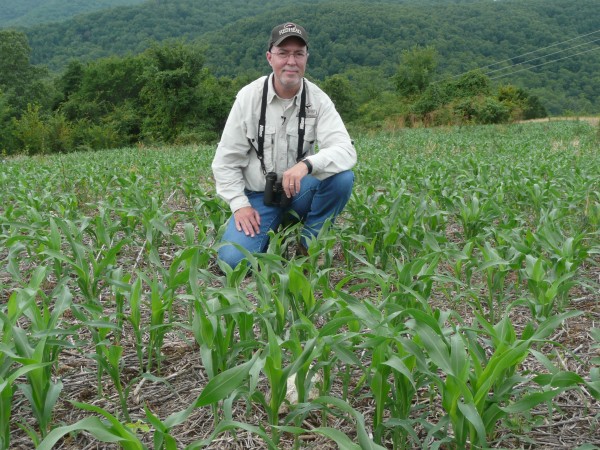Category: Hunting Blog
Deciding My Harvest Objectives
The old saying “You must know where you are going to get there” applies to deer hunting as much as other activities. By defining my harvest objectives, I have a much better chance of achieving my mission. I want to share in today’s blog my deer harvest objectives as deer season has begun or is about to begin throughout the whitetails’ range.
At my property, the harvest objectives are:
- To harvest as many does as necessary to balance the deer population with the habitat’s potential to provide quality forage during the periods of major stress (usually late summer and late winter).
- Allow bucks to mature to 4 years old or older.
I have objective #1 because I want quality forage available on a year round basis. Otherwise the deer couldn’t express their full fawn production or antler growth potential. Frequent watchers of GrowingDeer.tv know that I attempt to manage both the native habitat (using prescribed fire, timber management, etc.) and food plots to provide quality forage year round. Does are reproductive units – they produce fawns and the number of surviving fawns is the biggest factor in the deer herd’s current and future population.
If my quality food resources are becoming limited (known by checking browse pressure on preferred native species and using utilization cages in food plots) I must either create more quality food resources, reduce the number of deer competing for the food supplies, or do both simultaneously. Harvesting bucks is a very inefficient method to reduce deer populations. This is because one buck can breed many does. Hence, to limit fawn production, a vast majority of bucks must be removed annually. This results in a herd composed of mostly yearling bucks and gads of does. It rarely results in reducing the overall deer herd population – especially on a year to year basis.
To meet my habitat management objectives, my family, friends, and I will attempt to harvest approximately 2 does per 100 acres this fall. All the hunters at my place agree that harvesting does is one of the most enjoyable habitat management practices. I enjoy riding a tractor, but admit I’d rather be in a stand – I agree with my family and friends that harvesting does is an enjoyable habitat management activity. In fact, it is enjoyable twice! Once during the harvest activity and again when Mrs. Tracy prepares one of her wonderful venison dishes!!
I personally wish to harvest bucks that are four years old or older. Some of the primary reasons for this criterion are that antlers almost always increase in size with age (very few bucks – especially in my neighborhood) live past their prime body condition years. I’m not one bit afraid to admit I really enjoy seeing and harvesting bucks with large antlers. They thrill me as much as they did pre-historic men that painted antlers on cave walls throughout the world. I’m not sure what could be more natural than enjoying and harvesting bucks with large antlers! I also enjoy the challenge of attempting to tag a mature buck. Although the majority of venison my family consumes will be from does (doing habitat management and reducing my family’s grocery bill with extremely high quality meat!!) the buck I may harvest adds to our meat supply.
Another reason to allow bucks to mature is that they change the dynamics of deer herds. All the dynamics of mature bucks being present – pheromones, sign post, synchronizing breeding, reducing breeding activities of immature bucks, etc., are not totally understood. However the results (body weights, fawn production, antler development among all age classes, etc.) of a deer population that is in balance with the habitat’s ability to produce quality forage and has a mature age structure compared to herds that are malnourished and or have limited or no mature bucks is well documented.
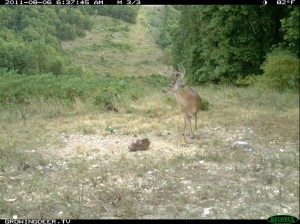
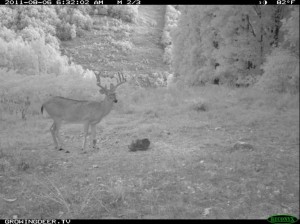 One of my harvest objectives for this fall is Clean 12. Clean 12 is a great buck for several reasons. He’s mature (probably 4 years old or older) based on the shape of his body. Hence, he’s survived at least four hunting seasons (as a 0.5, 1.5, 2.5, and 3.5 year old). There are 34 landowners that border my property. Many of these neighbors and their guests hunt and have different deer harvest objectives than me. Therefore Clean 12 is not easy prey. He has beautiful antlers – especially given there has never been a P&Y or B&C buck recorded in the counties (a county line splits my property) where I hunt.
One of my harvest objectives for this fall is Clean 12. Clean 12 is a great buck for several reasons. He’s mature (probably 4 years old or older) based on the shape of his body. Hence, he’s survived at least four hunting seasons (as a 0.5, 1.5, 2.5, and 3.5 year old). There are 34 landowners that border my property. Many of these neighbors and their guests hunt and have different deer harvest objectives than me. Therefore Clean 12 is not easy prey. He has beautiful antlers – especially given there has never been a P&Y or B&C buck recorded in the counties (a county line splits my property) where I hunt.
Those are the primary reasons Clean 12 is on my hit list. Take another look at the images of Clean 12. Did you notice the large wound on his left front leg? I’ve captured more than 50 images of Clean 12 this August during my annual camera survey. I never detected any sign of impaired mobility, leakage from the wound, etc., from those images. If I told you I was trying to harvest Clean 12 because he was suffering from injuries, I’d be lying – probably to myself more than to you.
I was (and still am) a hunter before I was a biologist. I’m thrilled that my hunting is a great tool to help improve deer herds! My family really enjoys the venison and time spent in a deer stand is very medicinal to the members of my family and me. Come September 15 (opening day for deer season in Missouri), I’ll be ready to begin my fall deer management activities.
Growing Deer together,
Grant
Antler Growth
There can be no argument that man has been intrigued by antlers and antler growth since the beginning of time. Antlers were the frequent subject of paintings, carvings, etc., by prehistoric man. I’ve yet to meet the child that didn’t accept an antler from my hand when offered. They tend to study the antler, count the points, rapidly notice the unique characteristics, etc. Almost everyone that visits my home comments on the light fixtures made from antlers or the sheds that Tracy uses to decorate our house. Antlers captivate humans from all cultures.
As a scientist and hunter, antlers captivate me. I understand the basics of how antlers are formed – the annual cycle of storing and mobilizing minerals. However, for a critter to grow something the size of a man’s arm and replace it annually is truly a miracle that even science struggles to understand fully.
As a hunter that appreciates creation, the fact that every antler is unique (like a human finger print) is astounding! I just finished the trail camera survey at my property. The unique shape of each buck’s antlers allowed me to identify dozens of unique bucks (from young to old). I wait until mid August to implement trail camera surveys each year so the antlers are developed enough to allow each buck to be specifically identified.
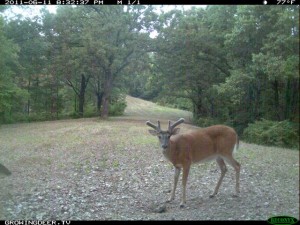 The image on the left taken during June is of a buck I call Clover Mountain Crab Claw. This buck has been present on my property for years. He is at least six years old. His rack has changed from having 8 points to 9 points and back to 8 typical points this year. I can usually accurately identify Clover Mountain Crab Claw by his body – he’s a tank! However, I wait until August to definitively confirm his identify and know that he has survived and avoided me for another year.
The image on the left taken during June is of a buck I call Clover Mountain Crab Claw. This buck has been present on my property for years. He is at least six years old. His rack has changed from having 8 points to 9 points and back to 8 typical points this year. I can usually accurately identify Clover Mountain Crab Claw by his body – he’s a tank! However, I wait until August to definitively confirm his identify and know that he has survived and avoided me for another year.
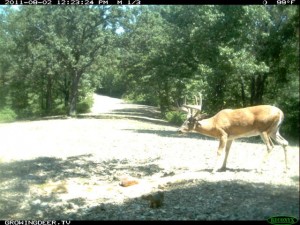 Hunting on the same property year after year allows sportsmen to learn much from the bucks whose range overlaps at least a portion of that property. It allows hunters to learn the general habits of bucks, and if they are good students, the individual movement patterns of each buck. Some bucks have a very large home range. Clover Mountain Crab Claw has a very small home range – as his picture is rarely captured at more than one camera station on my property.
Hunting on the same property year after year allows sportsmen to learn much from the bucks whose range overlaps at least a portion of that property. It allows hunters to learn the general habits of bucks, and if they are good students, the individual movement patterns of each buck. Some bucks have a very large home range. Clover Mountain Crab Claw has a very small home range – as his picture is rarely captured at more than one camera station on my property.
Watching the progress of antlers growing during the summer fascinates me. In addition, it allows me to learn the vast majority of bucks using my property. This is a huge benefit when hunting during the fall and trying to play by my own harvest guidelines. By being very familiar with the antler configuration of most of the 4+ year old bucks I can make rapid decisions of whether to shoot or not when a buck that appears mature comes in range. The thrill of being able to recognize the individual buck and know his estimated age is as fun to me as any other portion of the hunt.
Antlers are mysterious from a science and deer hunter’s point of view. They motivate us to spend gads of hours and resources attempting to learn more and obtain them. There is great value in antlers – and I believe the bulk of this value occurs before the buck is harvested. Those cave paintings have lasted and intrigued man for at least a few thousand years. So this fall when I’m spending many hours attempting to get my hands on a set of mature antlers, feel free to remind me of the joy I’ve already experienced watching one of the great mysteries of creation – watching antlers grow. If Clover Mountain Crab Claw avoids me again this year, I’ll still enjoy searching for his sheds and maintaining good quality habitat so I can see how his antlers develop next summer.
Growing (and chasing) Deer together,
Grant
Harvestable Mature Bucks
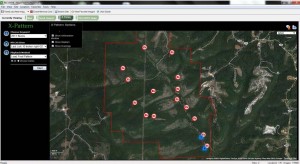
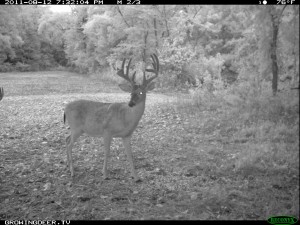 I enjoy studying mature bucks. My Reconyx trail cameras are one of the best tools available to study mature bucks. The cameras themselves don’t spook mature bucks, but there is more to the Reconyx than being a great trail camera. Each camera comes with a free software package, BuckView / MapView, that allows me to easily track the movements and see the pattern of mature bucks. The ability to track where bucks are moving on an aerial image of where I hunt is a tremendous tool.
I enjoy studying mature bucks. My Reconyx trail cameras are one of the best tools available to study mature bucks. The cameras themselves don’t spook mature bucks, but there is more to the Reconyx than being a great trail camera. Each camera comes with a free software package, BuckView / MapView, that allows me to easily track the movements and see the pattern of mature bucks. The ability to track where bucks are moving on an aerial image of where I hunt is a tremendous tool.
I dreamed of tools like this when I was in grad school. However, they were not available or simply cost too much. Now, for the price of a trail camera, I can monitor the movements of mature bucks. Technology is great!

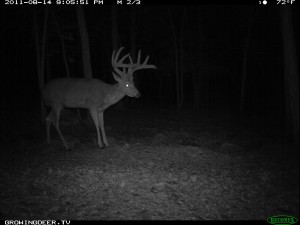 Monitoring the movement of mature bucks does not equate to harvesting a mature buck – but it sure helps. One thing it tells me is the amount of my property a mature buck is using. Some bucks will only use a small portion of a property or have a very small home range. Others mature bucks will have a larger home range or simply use more of the property. This later group includes the bucks that I will focus on while hunting.
Monitoring the movement of mature bucks does not equate to harvesting a mature buck – but it sure helps. One thing it tells me is the amount of my property a mature buck is using. Some bucks will only use a small portion of a property or have a very small home range. Others mature bucks will have a larger home range or simply use more of the property. This later group includes the bucks that I will focus on while hunting.
Bucks are like people – they have different personalities. Some of my friends were raised, got married, and have jobs in the same county where we were born. Others settled far away. As we matured, some of us travel far and wide frequently. Others feel more secure remaining close to their childhood home turf. The same is true with bucks. Each buck has an individual personality. Bucks that have a small range or only use a small portion of the property you hunt can be very difficult to kill. If a buck has a small range, he probably knows every wind current, tree, etc., very well. He can detect change/disturbance to his environment very easily.
Bucks that cover more area probably don’t know each acre nearly as well. In addition, if they are traveling more they are probably crossing more areas that are favorable to hunters (areas where the access, steady wind, etc., favor allowing hunters to select a stand location that won’t alert bucks).
For example, I’m just finishing the annual camera survey at The Proving Grounds. Two mature bucks are using one of my Trophy Rock sites, Last Lick. One of the bucks, Last Lick Right Kicker, only visited the adjoining camera site. He is currently only using a small part of the property where I hunt. I predict I won’t have many encounters with him this fall.
Another mature buck, Last Lick Big 10, is using that same Trophy Rock site and multiple others. When bucks travel relatively far during this time of year, they tend to be moving a lot during hunting season. Although Last Lick Big 10’s pattern may change once he sheds his velvet, I suspect my odds of having an encounter with him this fall are much better!
I’m currently moving my Reconyx units from the location where I do my annual deer herd survey (Trophy Rock locations) to monitoring travel corridors, feeding fields, etc. I’ll use the Reconyx software to track the patterns of these and other bucks. From past research and experience, I’m betting there’s a much better chance my taxidermist meets Last Lick Big 10 than Last Lick Right Kicker. I’ll let you know…
Growing (and hunting) Deer together,
Grant
Doing Laundry for Better Deer Hunting
Most deer hunters are actively preparing for deer season
My preparation includes:
- Habitat/food plot work
- Practicing with my chosen weapon
- Scouting
- Hanging stands/positioning blinds
- Preparing clothes
Most deer hunters engage in some of the above activities. However, one of the most important and often skipped stages is preparing hunting clothes.
A deer’s best defense against predators is its nose. A deer’s eyes and ears are good, but they are simply not in the same league as their nose. I believe that a deer’s nose can detect clothes that have remained in a house, plastic tub, etc., as these tend to have odors that are not common in deer habitat. These strange odors can alert and spook deer.
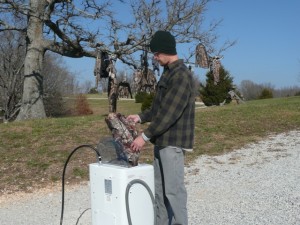 A deer’s reaction to detecting these odors is probably closely related to the current level of predator related stress the deer are experiencing. If they are being harassed by coyotes and other predators, the deer are likely very vigilant and will display a keen reaction to unusual smells.
A deer’s reaction to detecting these odors is probably closely related to the current level of predator related stress the deer are experiencing. If they are being harassed by coyotes and other predators, the deer are likely very vigilant and will display a keen reaction to unusual smells.
There is a lot of hunting at and adjoining my property. There are lots of coyotes in my neighborhood too. The topography is very hilly so the wind seems to swirl constantly. Given these crazy wind patterns, I must attempt to eliminate as many foreign odors as possible. To accomplish this, I wash all my hunting clothes with Dead Down Wind’s E1 Scent Prevent Laundry Detergent. Even though they were washed before being put up last year, I washed them again to remove as much odor as possible. Then I hung the clothes in the sun and allowed them to dry. The sun’s UV is an added cleansing agent.
When scouting or hunting, I use additional steps (shower, etc.) to remove as much scent from my body as possible. However, serious scent elimination means everything I take in the woods has been treated, washed, etc., to reduce scent.
Laundry is an important part of my hunting plan. It’s just as important as practicing with my bow – because without removing scent from my hunting clothes, my only shot this fall may be at the 3D targets in my yard.
Growing Deer together,
Grant
How to Pattern Bucks With Trail Cameras
Most of us would enjoy preparing to hunt knowing that the results of our scouting gave us much confidence that a mature buck was regularly passing within range of our stand. Scouting is a skill as much, if not more, than calling, shooting, and other hunting activities. With hunting season rapidly approaching, I wished to share some of my techniques for scouting using trail cameras. A neat thing about trail cameras is that they allow us to scout for individual deer, not just deer sign in general.
For example, finding scat, tracks, and evidence of browsing is great, but they don’t tell us with confidence if they were left by a buck or doe, or how mature the deer was. They also don’t tell us the time of day the deer was present. Trail cameras allow us to scout for a specific gender and/or age class of deer.
Knowing that deer need food, cover, and water, I typically use my Reconyx cameras to monitor food as quality food is usually in limited distribution during deer season in many areas. I also monitor other areas such as travel corridors. However, I don’t place my Reconyx cameras near my stands. The camera itself doesn’t spook deer, but me installing and retuning to check the camera can condition the deer, especially mature bucks, to avoid the area during daylight hours.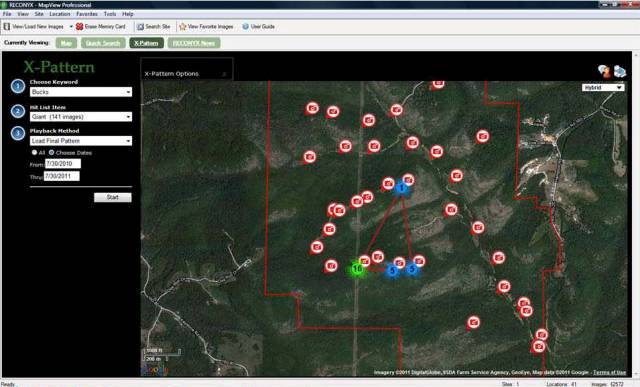
That’s why I typically monitor larger fields or feeding areas where I can approach in a truck and not walk very far to install and tend the camera. In addition, large openings are ideal for using the time lapse feature. Time lapse is simply taking an image of the opening every 15 minutes or so. This allows me to pattern deer using the field even if they are further from the camera than the detection area. Even though I might not be able to score a buck at 100+ yards in a trail camera image, I can identify him as a hit list candidate or not. This is another reason I use Reconyx units as the time lapse and auto detection systems will work simultaneously – giving me the best of both features!
The time lapse feature allows me to really limit disturbance in a possible hunting area and the detection mode gives images of outstanding image quality. Combining the advantage of scouting with a trail camera and knowing where a preferred food source is located is an outstanding technique. By using an electric fence and creating a gap in the fence, it’s relatively easy to pattern when and exactly where deer will approach a desirable food source. This is especially true during the late season when unprotected food sources have been consumed.
Organizing and making sense of the gads of trail camera images can be a sizable task. I know as I literally review 100,000+ Reconyx images from my place each year. Based on that experience, I provided Reconyx with suggestions of my dream tool to help organize the images and help me pattern mature bucks. This great scouting tool is provided free with Reconyx units and in my opinion is worth as much as the camera. It converts the data in the images to great maps that allow me to visually see how mature bucks are using my property and pick stand sites accordingly. A huge advantage of organizing images with this tool is that maps from all camera locations can be compared at once – not going back and forth looking at images on my laptop.
I used these maps last year to have an encounter with Giant 10 – the buck with the largest antlers at The Proving Grounds. I also used the maps generated by BuckView to find Giant 10’s sheds and to help one of my guests harvest a mature buck during the first day of her hunt.
As you prepare to hunt this year, consider using these scouting techniques and prepare to have some planned encounters with mature bucks at your Proving Grounds!
For more details about how to use trail cameras to scout, check out GDTV 66.
Growing (and patterning) Deer together,
Grant
M.R.I. – Scouting for Deer using Most Recent Information
It’s the time of year when my scouting for the upcoming season reaches a frenzied state. Scouting is simply an effort by the hunter to significantly increase his/her odds of observing and or harvesting the gender and age class deer of their choice. My mission is to harvest mature (4 year old or older) bucks. These bucks typically have a smaller core area and are extremely difficult to hunt without alerting them to your presence.
I’m constantly looking at Reconyx images, thinking about buck patterns I’ve learned about while managing the property during past years, etc. It’s critical to understand how bucks use the food, cover, and water resources available within their core area. Certainly some mature bucks will make trips outside their core area, but these trips can’t be predicted, and therefore can’t be counted on for the hunter to be successful.
Observations and data from past years are important in understanding how deer generally use a property. However, to place a stand so that mature bucks will walk within 40 yards requires M.R.I. – Most Recent Information.
The horrific drought that is currently ongoing in many states provides the perfect illustration for the value of M.R.I. Obviously sources of water that have been available in the past may not exist this fall. In some areas there may have been so many sources of water that bucks weren’t using any source of water regularly enough to establish a detectable pattern. That may not be the case this year and sources of water may provide the best option to pattern mature bucks.
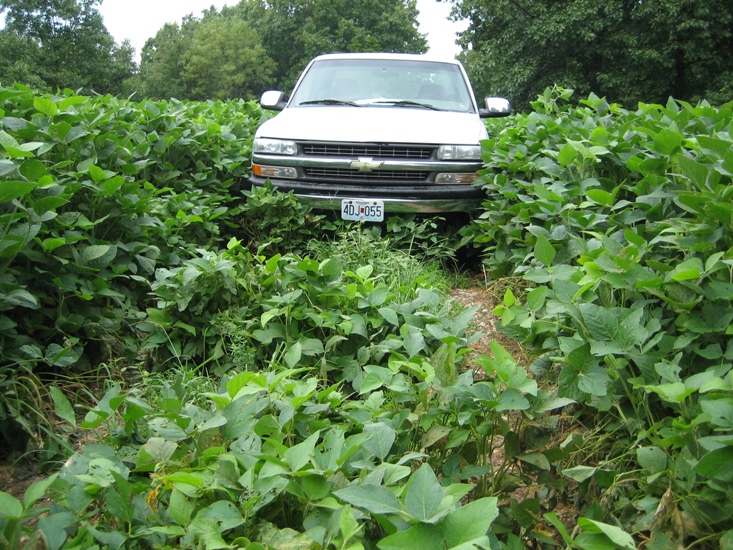
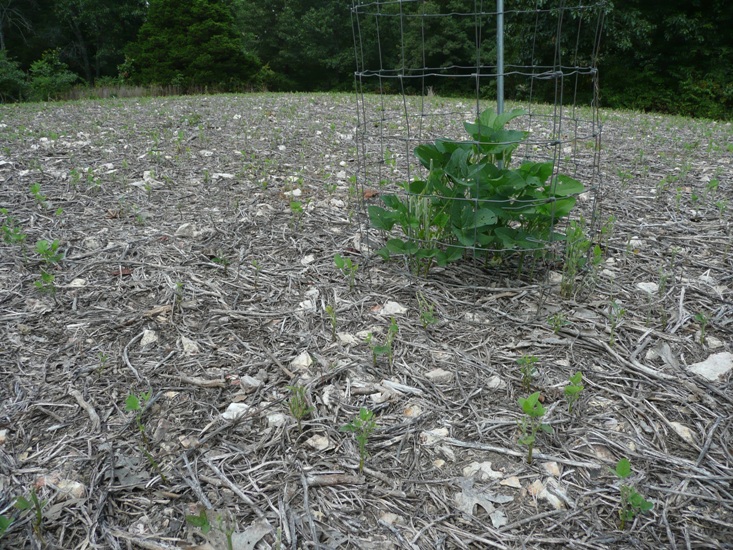
Food is another factor that may have very limited distribution in areas impacted by the drought. The images above are from the same food plot, taken during the same time of year. The local deer density didn’t increase that much from one year to the next. However, the growing conditions changed significantly! Growing conditions were average to slightly better than average during 2010. It was the 4th driest and the hottest July on record at the same location during 2011. Certainly deer feeding patterns will change from 2010 and 2011. Stand locations that were productive during 2010 may be a biological desert during 2011.
However, using M.R.I. to scout, 2011 may be a better hunting year. Finding the limited food and water resources may make for some fantastic stand locations!
By definition, M.R.I. changes rapidly. Don’t count on data from last year to place your stands this year. If you do, you might be watching a biological desert.
Growing (and hunting) Deer together,
Grant
The Need for Carbohydrates
Every year about the time bucks shed velvet they begin actively seeking a source of carbohydrates to consume. This drive to consume carbohydrates is a given annually. The Creator timed this perfectly as this is the time many sources of carbohydrates are becoming available such as acorns, corn, etc. Hunters in agricultural areas may not notice this dietary shift as deer often shift from the soybean to the adjoining corn field and still use the same bedding areas. Often times the bedding areas are the corn fields. I call production corn the annual forest as it grows tall enough to provide cover and is “clearcut” on an annual basis.
However, in areas that are primarily forested such as my neighborhood, deer may not find sources of carbohydrates as readily as deer living in the corn/soybean belt. Deer living in areas where forests are the primary cover type often readily seek acorns as a source of carbohydrates. Deer seeking acorns can be difficult to pattern.
Given this and the knowledge that deer annually seek carbohydrates this time of year, a grain crop in food plots can be a huge attractant during the hunting season. This is true in areas with agricultural and forest cover types. Most commercial agricultural fields are harvested by early to mid hunting season. However, having a grain crop, such as soybeans, corn, or milo to benefit and attract deer during hunting season can be a huge advantage!
This requires the food plot farmer to plan ahead. Grain production occurs during the summer growing season. If food plots are not planted until late summer, the only option is to produce forage during the hunting season. The traditional “green fields” will attract and benefit deer. However, grain tends to be a better attractant during the fall and carbohydrates are usually in a more limited supply than protein.
For great hunting during the fall, try planting a grain producing crop like soybeans, corn, or milo. Standing grain provides a great source of energy for deer and can be a great stand location.
Growing Deer together,
Grant
Antler Growth Patterns
Every year at this time I receive several questions related to how much more antler growth will occur. Folks want to know if a mature buck can add another 20” before velvet shed or what percent of antler development will occur still yet this year.
There is no certain answer for these questions. There are simply too many variables. Two of them are easy to describe. I was one of the tallest kids in my first grade class, if not the tallest. Everyone wanted me on their basketball team during recess. However, by the time I was a freshman in high school, I was only slightly above average height (I’m a tad over 6’ now). No one was screaming for me to be on their basketball team then. Some kids that I was much taller than in first grade were inches taller than me in high school.
I share this information not because I wish to play basketball, but as an illustration about antler development. Some bucks tend to grow more during the early portion of the antler growth season and some add a significant amount of inches during the last few weeks before velvet shed. On average, most bucks are finished adding a significant amount of antler by mid August. However, each buck is a unique individual just like humans are each unique. The best we can do is to manage based on the averages.
Another factor is the growing conditions. The severe drought that is impacting many states throughout the whitetails’ range could certainly limit antler development. Bucks that are feeding on irrigated crops may not show as much reduction in antler development as bucks that live where crop production is extremely limited by lack of water and heat stress.
The other extreme is also true. Bucks that live in areas with a closed canopy forest or other areas where growing season forage is extremely limited may not have significantly less antler development this year compared to normal growing conditions as there simply isn’t much quality forage to limit no matter what the conditions.
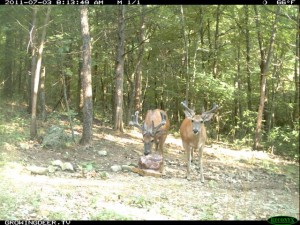
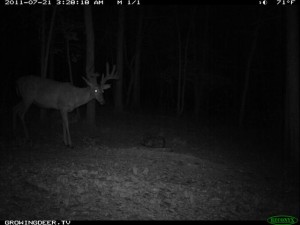 At The Proving Grounds, based on trail camera images, it does seem some of the mature bucks didn’t produce much more antler from last week to this week. I feel comfortable this is because of the extremely harsh drought conditions. The two images are of a buck I named Heavy 10. The images are about 1 week apart, but I can’t tell any increase in antler development. I’ll keep monitoring Heavy 10 and the other bucks for antler growth patterns. How are the bucks developing on your property?
At The Proving Grounds, based on trail camera images, it does seem some of the mature bucks didn’t produce much more antler from last week to this week. I feel comfortable this is because of the extremely harsh drought conditions. The two images are of a buck I named Heavy 10. The images are about 1 week apart, but I can’t tell any increase in antler development. I’ll keep monitoring Heavy 10 and the other bucks for antler growth patterns. How are the bucks developing on your property?
Growing Deer together,
Grant
How to Analyze Drought Stress on Whitetails
Iowa State probably does more research about growing corn than any other university. I have learned much about growing corn from their publications and staff. Iowa State’s Extension department publishes a great E newsletter titled Crop Management News.
The issue today does a great job of explaining how temperature and soil moisture availability impact the productivity of corn. As I’ve referenced frequently on recent episodes of GrowingDeer.tv, when growing conditions cause stress on forage or grain crops the critters are stressed also.
It is easier to monitor the impact of stress caused by drought on a corn crop. Researchers can simply sample many aspects of the crop on a daily basis. In fact, some of these factors (amount the leaves are twisted, tassel development, etc.) can be estimated from the comfort of a pickup.
It’s much more difficult to monitor deer. They are mobile and tend to be nocturnal. They don’t like to be held or measured. Capturing deer is not necessary to know that they are stressed when crops are not expressing their full potential. I’m not aware of an exact index that compares bushels of corn produced per acre that equates to inches of antler development per age class of bucks.
However when corn, soybean, alfalfa, etc., production is limited by harsh growing conditions, it is certain that deer won’t express their full potential. For example, today there was an Associated Press article posted on Fox News that quoted the Texas AgriLife Extension Service as reporting that pregnant does are having difficulty carrying fawns to term and other fawns are being born prematurely due to heat stress. Likewise the agricultural crops are very unproductive or a total failure in many parts of Texas. Tough growing conditions impact all living things!
That’s one reason I enjoy reading Crop Management News. It provides great information for growing quality food plots, and also provides a real-time index of the growing conditions for crops and deer in Iowa. In addition, the information is useful no matter where I wish to grow crops or deer!
Information is the most valuable tool for any profession. I hope this source of information helps you become a better deer manager.
Growing Deer together,
Grant
Scouting for Acorns: Where to Hang Your Treestand
It’s been another very hot day at The Proving Grounds! The thermometer on my truck showed 103 degrees. The native vegetation and food plot crops are showing signs of drought and heat stress. Unless the weather pattern at The Proving Grounds changes before fall, quality food sources will be limited and therefore the few good sources of food will be prime whitetail hunting locations! Acorns are not quality food for deer because they are extremely fibrous and tough to digest. However, deer find them very palatable (tasty) and readily consume acorns from most species of oaks.
Scouting for acorns is a good technique whether you hunt 40 or 4,000 acres. Ideal deer hunting can occur when oak trees are few and far between. This usually occurs when agriculture or other land use practices limit the amount of habitat that is forested. Another situation that produces great hunting is when only a few oaks in an area produce acorns. When these conditions exist, patterning deer may be as simple as lo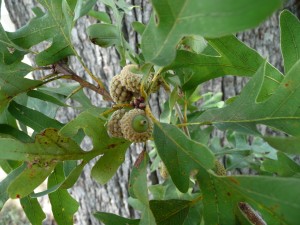 cating the trees that produced acorns and hunting near them without spooking deer.
cating the trees that produced acorns and hunting near them without spooking deer.
However, if oaks are common where you hunt, it can be extremely difficult to see deer during years when all the oak trees produce acorns. This is because deer can eat and bed within an extremely small area. Hunters simply can’t approach these areas without alerting deer! It’s tough to get between the feeding and bedding area when they are literally just a few yards apart.
One nice characteristic of acorns is that they take months to develop. Therefore hunters can scout and place stands during July and August, well before deer season, with confidence that acorns will be present at the same location during hunting season. Knowing which types of acorns deer prefer during the early (from the white oak family) versus late (from the red oak family) season can be a key to hanging stands in locations that fit your hunting schedule. I hope you get some time to scout for acorns soon. Limit disturbance during deer season by scouting and hanging stands now!
Growing Deer together,
Grant



